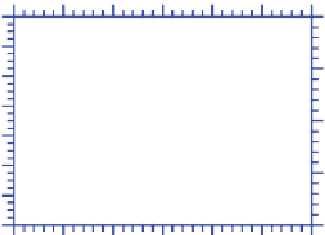Geoscience Reference
In-Depth Information
14
2
120
20
12
100
O
3
(g)
PM
2.5
15
1.5
10
80
8
1
60
10
6
Pb(s)
SO
2
(g)
40
CO(g)
4
0.5
5
20
2
NO
2
(g)
0
0
0
0
1980
1990
2000
2010
1980
1990
2000
2010
(a) Year
(b) Year
Figure 8.1.
Air quality trends for (a) gases and (b) particle components or types in the United States,
1980-2009. From U.S. EPA (2011c). Ozone data are based on annual fourth maximum 8-hour averages at 255
sites; carbon monoxide data are based on annual second maximum 8-hour averages at 114 sites; nitrogen
dioxide data are based on annual arithmetic averages at 81 sites; sulfur dioxide data are based on annual
arithmetic averages at 134 sites; PM
2.5
data are based on seasonally weighted annual averages at 724 sites;
lead data are based on annual maximum 3-month averages at 20 sites.
with each level. When an ozone smog alert occurs,
individuals are advised to limit outdoor activity to morn-
ing or early evening hours because ozone levels peak
in the midafternoon. Outdoor activities in schools are
usually eliminated during a smog alert.
Health advi-
sories
for ozone were initiated in California in 1990 by
the California Air Resources Board because evidence
indicated that ozone levels above the federal standard
and below a Stage 1 smog alert may affect healthy,
exercising adults. When a health advisory occurs, all
individuals, including children and healthy adults, are
advised to limit prolonged and vigorous outdoor exer-
cise. Individuals with heart or lung disease are advised
to avoid outdoor activity until the advisory is no longer
in effect.
Baton Rouge, and Atlanta. These locations shift over
time, however.
Although U.S. pollution levels are still severe, they
have improved since the 1950s. Much of the improve-
ment can be attributed to regulations arising at the dis-
trict, state, and federal levels. Figure 8.1 shows ambient
levels of several gas and particle pollutants, averaged
overU.S. air monitoring stations, from 1980 to 2009. It
also indicates a
marked decrease in lead concentra-
tions
, due primarily to the phase-out of leaded gasoline,
and more gradual but noticeable decreases in the other
pollutants. NO
2
(g) and O
3
(g) decreases have lagged
behind CO(g) and SO
2
(g) decreases. PM
2.5
measure-
ments commenced only in 2000.
The Los Angeles Air Pollution Control District,
formed in 1947 and now part of the SCAQMD, has been
at the forefront in initiating regulations that were ulti-
mately adopted at the federal level. Despite the fact that
Los Angeles is still the most polluted city in the United
States in terms of ozone (Table 8.4), improvements in air
quality resulting from regulation there have been signif-
icant. Figure 8.2a shows the maximum ozone levels and
the number of days per year that California state stan-
dards, federal standards, health advisory levels, Stage 1
alerts, and Stage 2 alerts were exceeded between 1973
and 2009 in the Los Angeles Basin. Between 1973 and
2009, the highest ozone level recorded in the Los Ange-
les Basin was 0.51 ppmv (1974). The California state
ozone standard, which was exceeded 219 days in 1976,
wasexceeded only 102 days in 2009. Between 1976
and 2009, NAAQS exceedances were reduced from
176 to 15 days per year, and Stage 1 and 2 alerts were
8.1.15. U.S. Air Quality Trends from
the 1970s to Present
Between 2006 and 2008, 175 million people (58 per-
cent of the U.S. population) lived in U.S. cities with
unhealthful air (American Lung Association, 2010). In
terms of ozone, eight of the ten most polluted cities
were in California, with Los Angeles being the most
polluted. In terms of annual particulate matter pollu-
tion, five of the ten most polluted cities were in Cali-
fornia, with most in the Central Valley. Historically, the
regions of the United States in which air quality prob-
lems have been most severe are in central and Southern
California, the Boston through Washington (BoWash)
corridor, the Milwaukee through Chicago Great Lakes
Region, Phoenix, El Paso, Dallas-Ft. Worth, Houston,












































Search WWH ::

Custom Search